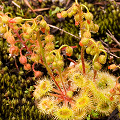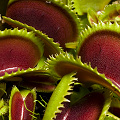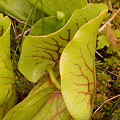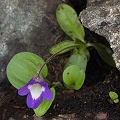Citation information to Barry's book
When I wrote my carnivorous plant book, I included in-text citations, as is typical for a scientific publication. My editors balked at this, and removed nearly all these. However, since you--the mighty and lively reader--might find increased pleasure in learning more, I felt it was important I cite these fine authors. So here, I provide to you a chapter-by-chapter, page by page citation guide. Refer to the book bibliography for the complete references. I hope I caught them all, but please point out any obvious oversights!
Chapter 1:
P13, re: Burnett (Juniper, et al. 1989)
P18, re: classification system (Anonymous 2005)
Chapter 2:
P25, re: surprising relationships (Schnell 2002; Clarke 1997, 2001)
P26, re: frog eggs (Clarke 1997)
P28, re: new fossils (Li 2005)
Chapter 3:
P32, re: Hooker Zones (Juniper, et al. 1989)
P33, re: single gigantic gland (Juniper, et al. 1989)
P38, re: Utricularia general plan (Lloyd 1942; Schnell 2002)
Chapter 4:
P43, re: Daphnia absorption (Fabian-Galan & Salageanu 1968)
P43, re: Phosphates (Juniper, et al. 1989)
P45, re: touching trigger hairs (Lloyd 1942)
P45, re: 3-7 days (L. Adamec, pers. communication 2005)
P47, re: Okavango Swamp (L. Adamec, pers. communication 2005)
P48-49, re: Adamec protocol (Adamec 1997)
P49, re: Darnowski method (Darnowski 2002)
P51, re: Aldrovanda inopinata (Schlauer 1997, and references therein)
P51, re: TC conservation (Kondo 1997)
Chapter 5:
P53, re: egg digestion (Bruce 1905)
P55, re: Absence of Byblis liniflora enzymes (Hartmeyer 1998)
P55, re: Presence of B. filifolia, B. gigantea enzymes (Bruce 1905; Wallace 1999)
P59, re: Byblis aquatica resting on water (Lowrie & Conran 1998)
P59, re: Presence of B. filifolia enzymes (Wallace 1999)
Chapter 6:
P61, re: Guichenot (Juniper, et al. 1989)
P61, re: sac-bearing, headed one (R. Gibson, pers. communication 2005; J. Schlauer, pers. communication 2005)
P62, re: "vegetable hedgehog"(Hamilton, in Lloyd 1942)
P62, re: red to black (Mann 2005)
P62, re: 60 cm in diameter (Gibson 2001)
P63, re: capillary mat (Tran 2001)
P63, re: 2:1 sand:peat (D'Amato 1998a)
P63, re: feral pigs (Gibson 1999; Mann 2005)
Chapter 7:
P65, re: delightful observations (Juniper, et al. 1989; Schnell 2002)
P68-69, re: pigmentation patterns (Rice 2001)
Chapter 8:
P73, re: Miraculum Naturae (Nelson & McKinley 1990)
P73, re: unwary mammals (Nelson & McKinley 1990)
P73, re: recent research (citations in Juniper, et al. 1989; and Schnell 2002)
P75, re: Treefrogs (P. D'Amato, pers. communication 2005)
P73, re: 37 sites destroyed (Russo 1993, and citations therein)
P77, re: natural wildfowl introduction (Schnell 2002)
P78, re: 50% decrease in sunlight (Roberts & Oosting 1958)
P78, re: climate data (http://www.weather.com, accessed July 2002)
P78, re: development shifts to golf courses (M. Boyer, pers. communication 2005)
Chapter 9:
P83, re: 1780 observations (citations in Lloyd 1942)
P92, re: Drosera glanduligera tentacles (S. Hartmeyer & R. Davion, pers. communication 2005)
Chapter 10:
P95, re: "slobbering pine" (Flísek & Pásek 2001)
P97, re: activating sessile glands (Fenner 1904)
P98, re: oak harvesters (Flísek & Pásek 2001)
P98, re: glandular cotyledons (França, in Lloyd 1942)
P98, re: nesting pots (Slack 1986)
P99, re: military activities (Juniper, et al. 1989; Correia & Freitas 2002)
Chapter 11:
P101, re: 1975 discoveries (cited in Barthlott, et al. 1998)
P101, re: Definitive proof (Barthlott, et al. 1998)
P101, re: Attracting Paramecium (Barthlott, et al. 1998)
P102, re: technical descriptions (Taylor 1967, 1991; Fischer et al. 2000)
P102, re: active trap? (Barthlott, et al. 1998; Rice 1994)
P102, re: passive trap? (Adamec 2003)
P102, re: mucus trap and oxygen (Studnicka 2003a, 2003b)
P102, re: wild hybridization (Barthlott, et al. 2000)
Chapter 12:
P113, re: cultivation (Ziemer 1979; Dodd & Powell 1988; and of course D'Amato 1998a)
P115, re: fire rings (Sears 2001)
Chapter 13:
P117, re: Flacourt (Phillipps & Lamb 1996)
P117, re: Hooker's experiments (e.g. Hooker 1874)
P117, re: Digestive enzymes (Frazier 2000)
P118, re: Mycorrhizal association (Moran, in Clarke 2001)
P120, re: pitchers stripped of wings (Moran 1993)
P120, re: odors from pitchers (Moran 1996)
P120, re: prey broken down in hours (Clarke 2001)
P121, re: frog gloves (Clarke & Moran, in Clarke 2001)
P121, re: vegetarianism (Moran, et al. 2003)
P121, re: Nepenthes inermis (Clarke 2001)
P122, re: highland, lowland classifications (Clarke 1997, 2001; Danser 1928; Jebb & Cheek 1997; original species
descriptions)
P126, re: growers in tropics (C. Clarke, pers. communication 2005)
P127, re: conservation threats (Clarke 2001)
P127, re: Nepenthes clipeata conservation (Cantley, et al. 2005; Rice 2005)
Chapter 14:
P135, re: powerful blend of enzymes (Heslop-Harrison & Knox 1971)
P135, re: possible motiviations (Studnicka 2001)
P135, re: within only a few hours (Heslop-Harrison & Knox 1971)
P136, re: how to look after (D'Amato 1998a)
P136, re: baggies in the refrigerator (Rice 2002)
P137, re: Pinguicula casabitoana (P. Temple, pers. communication 2001)
P137, re: Pinguicula poldinii poaching (F. d'Alessi & F. Tassara, pers. communication 2003)
Chapter 15:
P139, re: bacterial activity (Hepburn, et al. 1920a, 1920b)
P139, re: radioisotope-tagged nutrients (Plummer & Kethley 1964; Williams 1966)
P139, re: global climate change (Bradshaw & Holzapfel 2001)
P143, re: 4-week stratification (Ellison 2001)
P144, re: seven S. flava color varieties (Schnell 1998)
P145, re: submerging S. psittacina (S. Millar, pers. communication 2005)
P146, re: 3-5 S. rubra subspecies (Schnell 2002; Case & Case 1976)
Chapter 16:
P149, re: Mary Treat (Lloyd 1942)
P150, re: to more fully understand the genus (Taylor 1989)
P159, re: Australian species with small ranges (Taylor 1989)
Chapter 17:
P161, re: Utricularia purpurea (Richards 2001)
P161, re: Nepenthes lowii (J. Moran, in Clarke 1997)
P162, re: cracks in leaves (Anderson 2005)
P162, re: radio-isotopes (Ellis & Midgely 1996)
P162, re: cultivation (Opel 2005)
P163, re: inconclusive bromeliad evidence (Schnell 2002)
P163, re: Marburger (J. Marburger, pers. communication 2005)
P163, re: German cultivators (Bringmann, et al. 2002, and references therein)
P164, re: no indication of enzymes (Rice 1999b)
Chapter 18:
P176, re: D'Amato and coco peat (D'Amato 1998b, 1999, 2000)
Chapter 19:
P191, re: tissue culture (Darnowski 2004)
Chapter 20:
P196, re: 4-6 weeks (Ellison 2001)
P197, re: some experts (Lowrie & Conran 1998)
P197, re: others use 1/10th (D'Amato 1998a)
P197, re: international cultivar code (Brickell, et al. 2004)
Chapter 21:
No deletions
Chapter 22:
No deletions
Utricularia deviations from Taylor
My treatment of Utricularia in Chapter 16 closely follows
Taylor (1989), as you might expect. However, in the years since Taylor's global monograph was published, there have been a few
additions and subtractions from the
list of Utricularia that are commonly recognized. Although I don't necesssarily completely agree with all of them,
I adopted them in my book. The differences between my book's lists and Taylor (1989) are noted below.
My book addendum list has other new species, and more significantly
changes based upon phylogenetic research. These changes are described more in my
online FAQ.
Additions
U. beaugleholei
U. chiakiana
U. malabarica
U. paulineae
U. petertaylorii
U. stygia
U. subramanyamii
Eliminations
U. monanthos--lumped with U. dichotoma
U. nova-zelandiae--lumped with U. dichotoma



